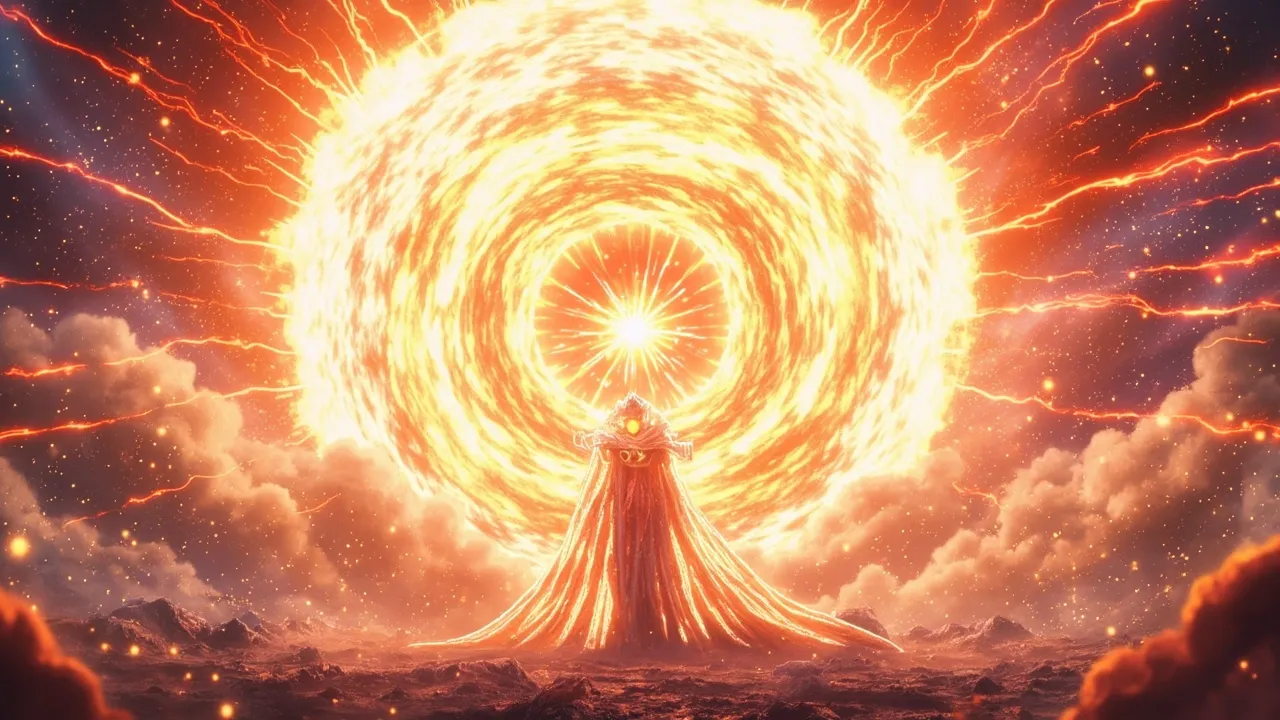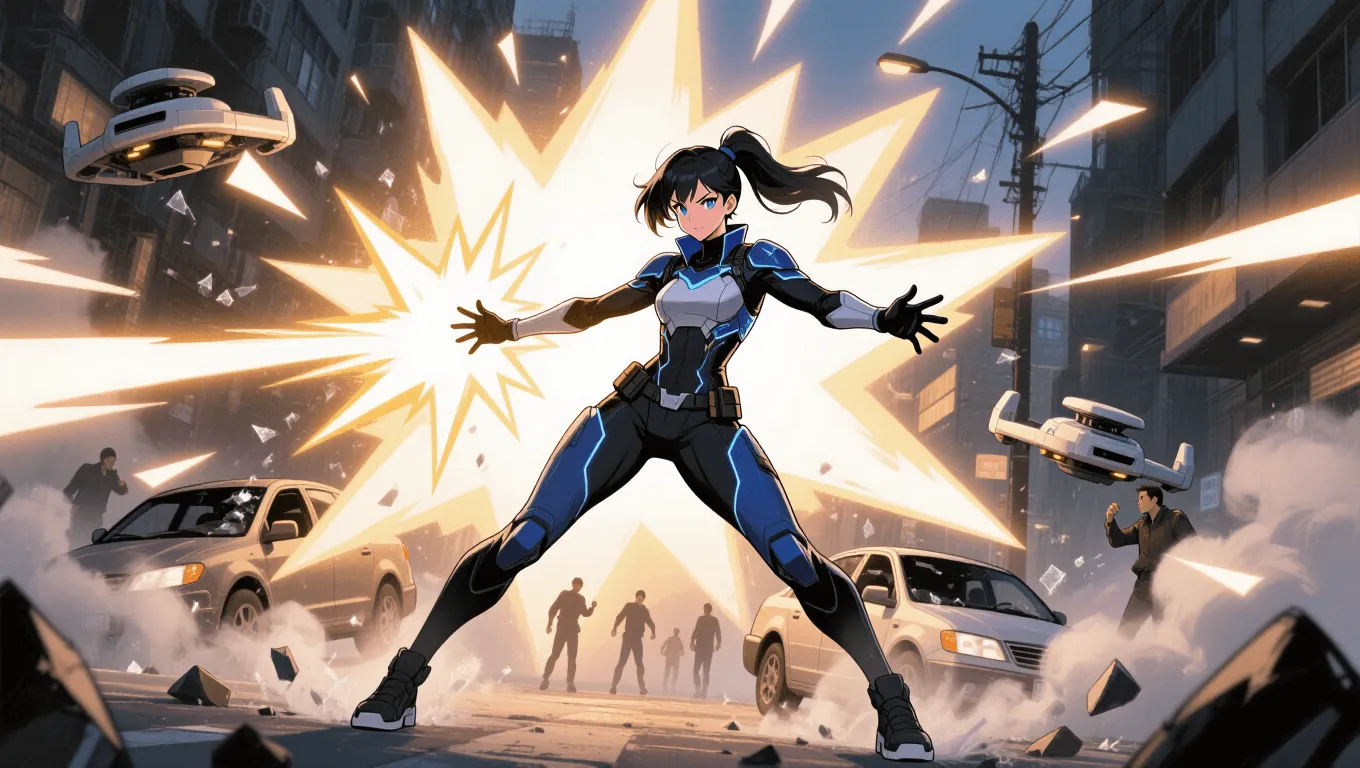Nova Cataclysm

Nova Cataclysm Video Demo 🎬
Table of Contents
- Nova Cataclysm Video Demo 🎬
- What Is Nova Cataclysm
- Core Abilities of Nova Cataclysm
- Application / Tactical Advantages in Combat
- Level: Level 1 🏙️, Level 2 🌇, Level 3 🌃
- Limitations of Using the Nova Cataclysm
- Weakness Against What Other Superpowers
- Synergistic Power Combos
- Known Users
- Training and Safety Guidelines
- Power Variants and Evolutions
- How It Compares to Other Energy Powers
Nova Cataclysm is a high-intensity energy burst ability that mimics the destructive brilliance of a stellar explosion. As the name suggests, Nova Cataclysm concentrates cosmic-scale power into a sudden detonation or sustained flare, unleashing radiation, shockwaves, and searing light. This guide explains what Nova Cataclysm is, its core abilities, combat applications, scalable levels, limitations, weaknesses, synergistic combos, and known users. For more powers like this, explore the full list on the superpower wiki and try discovering new ideas with the random superpower generator.
What Is Nova Cataclysm
Nova Cataclysm is a superpower that channels concentrated stellar energy—akin to a supernova flash or solar flare—into devastating bursts. Unlike general energy projection, Nova Cataclysm prioritizes catastrophic output over endurance. Users compress photonic, thermal, and radiation forces into a compact core and detonate it outward as a sphere, beam, or layered wavefront.
At a conceptual level, the power replicates phenomena seen in extreme astrophysics: photon-rich pulses, coronal mass ejection–like arcs, thermonuclear heat fronts, and subsonic-to-supersonic shock transitions. Practically, it manifests as a controllable starburst capable of clearing battlefields, disabling war machines, or ending duels in a single flash. Because of this, Nova Cataclysm tends to be a finisher rather than a sustained fighting style, with precision, cooldown management, and safety protocols defining mastery.
Core Abilities of Nova Cataclysm
Stellar Burst Emission
The signature move is a radial detonation centered on the user or a designated point. The burst produces intense light, scorching heat, and kinetic pressure. Area-of-effect radius scales with charge time and user proficiency.
Photon-Lance Projection
Energy can be collimated into a coherent spear of light—sometimes called a photon lance or cataclysm beam—for precision work. This reduces collateral damage while retaining armor-piercing potency.
Radiation Spectrum Control
Advanced users can shift the emission spectrum (visible, ultraviolet, soft x-ray) to bypass conventional shields or sensors. Lower-energy spectra are used for crowd control; higher-energy spectra threaten hardened targets.
Shockwave Shaping
By timing the detonation curve, users sculpt concussive shockwaves: hemispherical pushes to clear space, ring-shaped waves to trip and disarm, or focused implosions to crumple fortifications.
Thermal Field Generation
A short-lived thermal corona surrounds the user during or after the blast, vaporizing projectiles, melting restraints, and creating pressure gradients that deflect incoming attacks.
Cataclysmic Charge Storage
Energy can be banked as a “white dwarf” core inside the body or an external focus (gauntlet, reactor, sigil). Stored charge enables delayed detonation, chained bursts, or emergency flares.
Afterglow Utility
Residual light and ionization enable battlefield illumination, sensor blinding, and short-range EMP-like disruptions against fragile electronics.
Application / Tactical Advantages in Combat
Area Denial and Crowd Control
A low-yield detonation forces enemy repositioning, denies corridors, and pins aerial threats with turbulent updrafts. Flash components can disorient without lethal thermal output when calibrated precisely.
Anti-Armor and Breach Operations
Photon-lance projection penetrates composite plating and reactive fields. Shockwave shaping collapses doors and ferrocrete without vaporizing the surroundings, minimizing structural fires.
Anti-Missile and Counter-Barrage
Thermal fields and outward pressure cones prematurely detonate warheads or deflect kinetic slugs. The bright flare also disrupts optical guidance.
Tempo Control and Finishing Blows
Because Nova Cataclysm spikes damage in an instant, it flips tempo against durable opponents. Users can feint with small flares, bait defenses, then trigger the primary burst during an opening.
Environmental Synergy
In low-oxygen or vacuum environments, radiative heat transfer dominates; the blast remains effective where combustion-based powers falter. In atmosphere, shock and convection amplify crowd-control effects.
Level: Level 1 🏙️, Level 2 🌇, Level 3 🌃
Level 1 🏙️ – Street-Scale Starburst

-
Output: Comparable to military-grade explosives localized within a 10–30 meter radius.
-
Manifestations: Dazzling flash, painful heat, concussive push strong enough to topple vehicles at close range.
-
Control: Basic modulation between radial burst and short, bright beam. Simple eye-safe training flares are possible.
-
Use Cases: Crowd dispersion, emergency escapes, breaching doors, disabling drones and lightweight exosuits.
-
Risks: Collateral damage from shattered glass, fires in flammable zones, temporary blindness to allies without proper signaling.
Level 2 🌇 – District-Scale Cataclysm

-
Output: City-block influence; can crater streets, slag armored platforms, and punch through bunker faces.
-
Manifestations: Multi-layer shockfronts, persistent afterglow, visible corona arcs resembling coronal mass ejections.
-
Control: Beam precision extends to surgical strikes at hundreds of meters; spectrum shifting permits anti-shield strategies.
-
Use Cases: Anti-armor, siege breakthroughs, intercepting missile salvos, clearing killboxes.
-
Risks: Ionization can disrupt emergency comms; heat plumes threaten infrastructure. Strict rules of engagement and countdown protocols advised.
Level 3 🌃 – Theater-Scale Superflare

-
Output: Catastrophic. Comparable, in brief pulses, to tactical-yield events without fallout. Terrain reshaping and long-range EMP-like disturbances may occur.
-
Manifestations: Horizon-bright flash, towering pressure dome, magnetic writhing in metal.
-
Control: Requires external foci or containment seals; microsecond timing windows to prevent runaway.
-
Use Cases: Ending large-scale engagements, disabling invasion craft, planetary defense emergencies.
-
Risks: Severe radiological hazards (non-ionizing and ionizing bands), atmospheric ignition risk in extreme misfires, and long cooldowns that leave the user vulnerable.
Limitations of Using the Nova Cataclysm
-
Charge Time: Building a stable core takes seconds to minutes depending on scale. Telegraphed preparation invites counterplay from snipers, speedsters, and teleporters.
-
Cooldown and Overheat: Post-detonation fatigue, skin burns, and heatstroke-like symptoms are common without thermal regulation. Overuse risks organ damage.
-
Line of Sight and Geometry: Urban canyons and reflective surfaces create dangerous backscatter. Underground or submarine environments may blunt shockwaves or create cavitation hazards.
-
Precision vs. Power Tradeoff: Narrow beams reduce collateral damage but bleed total output; wide bursts increase friendly-fire risk.
-
Resource Dependency: Some variants require solar exposure, cosmic background tapping, or specialized batteries/reactors to reach peak yield.
-
Legal/Ethical Constraints: At district scale and beyond, Nova Cataclysm is heavily regulated. Authorization, evacuation, and ally eye/ear protection protocols are mandatory.
Weakness Against What Other Superpowers
-
Energy Absorption/Redirection: Powers that drink in photonic or thermal energy can neuter the detonation or reflect it (e.g., mirror-field manipulators).
-
Phase Shifting/Intangibility: Intangible targets let beams pass harmlessly; shockwaves couple poorly with phased matter.
-
Gravity Manipulation: Gravitic wells can bottle or deflect the expanding sphere, forcing a premature implosion or dissipating it into harmless heat.
-
Vacuum Sealers and Null Fields: Power nullification domes and entropy cages strip the user of charge or force subcritical fizzling.
-
Extreme Cold/Heat Sinks: Cryokinetic sinks wick heat rapidly, shrinking thermal damage footprints; exotic heat siphons drain the corona.
-
Speedsters and Blinkers: High-velocity enemies close gaps during charge windows or reposition allies outside the blast radius.
Synergistic Power Combos
-
Graviton Shear + Nova Cataclysm: A teammate’s gravity lensing compresses the burst into a tighter cone, increasing penetration and reducing collateral light scatter.
-
Force Hardlight Screens + Nova Cataclysm: Projected barriers shape the shockfront into arcs, creating “safe corridors” for allies while amplifying push in enemy lanes.
-
Temporal Micro-Stall + Nova Cataclysm: Millisecond time dilation stabilizes the charge curve, enabling overclocked blasts that would normally collapse or misfire.
-
Magnetic Conduction + Nova Cataclysm: Magnetokinetics guide ionized plasma filaments along rails for chained strikes—useful against drones and powered armor.
-
Aero-Thermal Vortex + Nova Cataclysm: Aerokinesis spins a vortex that contains heat, cooking hostile zones while shielding nearby structures.
-
Bio-Regeneration + Nova Cataclysm: Healers counteract the user’s burnout, cutting downtime between detonations.
-
Geo-Anchoring + Nova Cataclysm: Geokinetics pin the user or erect berms to resist self-knockback and site the blast safely.
Known Users
-
Starflare Regent (Independent Hero): A disciplined protector who uses district-scale flares only under strict evacuation protocols. Their public playbook emphasizes countdowns and visible hand signals to warn civilians.
-
Sunbreak Legionnaire (Paramilitary Operative): An orbital drop specialist who pairs photon lances with kinetic spears, breaching anti-air batteries before they can lock on.
-
Carol Danvers, Captain Marvel (Analogous Ability): While not identical, certain portrayals feature stellar energy absorption and high-yield photonic blasts that resemble a contained nova event. Learn more about the character at the Marvel Database entry for Captain Marvel.
-
Radiant Monk of the White Dwarf (Mythic Order): A monk-scholar who stores a “white dwarf heart” in a talisman, releasing classroom-safe flares for training and city-safe bursts for defense.
-
Arcus of the Dawnwatch (Team Tactician): Known for gravity-lensed beams that carve surgical corridors through enemy lines while leaving allied routes untouched.
Training and Safety Guidelines
Calibration Drills
-
Lumens and Heat Scaling: Begin with flashlight-level glows, progress to welding-arc intensity, then controlled flare bursts against inert targets.
-
Pulse Timing: Practice micro-bursts at increasing frequencies to learn where heat buildup begins to threaten self-injury.
Protective Measures
-
Eye and Skin Protection: Allies should wear auto-dimming visors and thermal-resistant fabric. The user should employ internal dampeners or external heat-sink gear.
-
Range and Signaling: Use visual countdowns and radio calls. Mark safe zones with arrow beacons before a high-yield discharge.
-
Environmental Checks: Avoid fuel depots, hospitals, or data centers unless absolutely necessary; consider wind direction and confined-space risks.
Ethical Deployment
-
Proportionality: Use the smallest effective yield.
-
Accountability: Log charge levels, blast radii, and collateral outcomes after each mission.
-
De-escalation: Favor photon-lance precision and disorienting flashes over wide-area burns when civilians are present.
Power Variants and Evolutions
-
Solar-Linked Nova: Output scales with sun exposure; eclipses hinder performance, while spacewalks supercharge it.
-
Void-Cored Cataclysm: Uses a micro void as a pressure sink to draw material inward before the outward flare—more control, higher risk.
-
Harmonic Nova: Synchronizes multiple micro-bursts to build a meta-shockwave that moves like a ripple, bending around allies.
-
Prismatic Cataclysm: Splits the release into color-coded bands for different effects—blinding white for disorientation, blue-white for armor melting, violet for sensor disruption.
How It Compares to Other Energy Powers
Nova Cataclysm differs from generic energy projection by its emphasis on catastrophic, burst-centric output. It is less about sustained beams and more about timing, geometry, and controlled devastation. Compared to pyrokinesis, it relies on radiative and photonic transfer rather than combustion chemistry, allowing efficacy in vacuum. Compared to electricity manipulation, it couples less with conductors and more with surface ablation and shock physics, making it ideal against mixed-material defenses.
For more superpower deep-dives, browse the superpower wiki and generate fresh character ideas with the random superpower generator.
